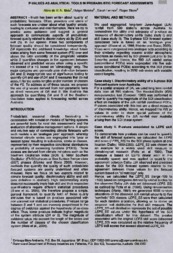P-Values as analytical tools in probabilistic forecast assessments.
P-Values as analytical tools in probabilistic forecast assessments.
Author(s): MAIA, A. de H. N.; MEINKE, H.; LENNOX, S.; STONE, R.
Summary: Much has been written about ?quality? of probabilistic forecasts. Often, providers and users of such forecasts are unclear about what ?quality? entails, leading to confusion and misinformation. Here we try to provide some guidance and suggest a general approach to communicate aspects of probabilistic forecast quality related to discriminatory ability (DA) and skill (S). In our opinion, these two components of forecast quality should be considered independently. DA represents the additional knowledge about future states arising from some forecast system (FS) over and above the total variability of the prognostic variable while S quantifies changes in the agreement between observed and predicted values when using a specific FS instead of a FS based on ?climatology? only. The major concerns are: generally poor distinction between DA and S; inappropriate use of significance testing to quantify DA and use of DA and S measures that do not account for the series lengths and/or number of classes of the FS. To address all of these issues, we propose the use of p-values derived from non-parametric tests as direct measures of DA and S. We illustrate this approach by quantifying DA and S of the Southern Oscillation Index applied to forecasting rainfall across Australia.
Publication year: 2005
Types of publication: Paper in annals and proceedings
Unit: Embrapa Environment
Observation
Some of Embrapa's publications are published as ePub files. To read them, use or download one of the following free software options to your computer or mobile device. Android: Google Play Books; IOS: iBooks; Windows and Linux: Calibre.
Access other publications
Access the Agricultural Research Database (BDPA) to consult Embrapa's full library collection and records.
Visit Embrapa Bookstore to purchase books and other publications sold by Embrapa.

